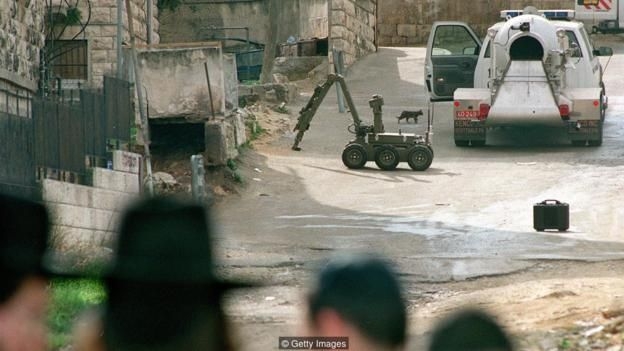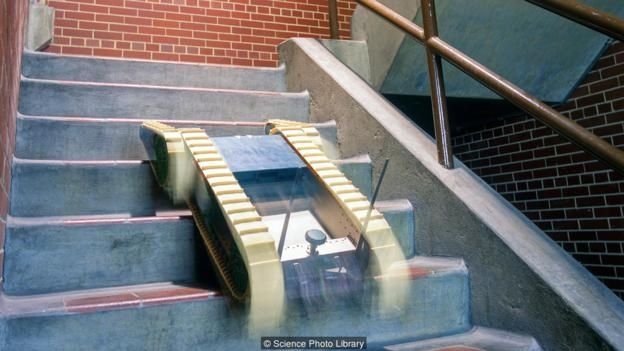Humans cannot walk through the road full of bombs, but robots can calmly face it. Demolition of bombs is the most dangerous job in all robotic applications, because every step of the robot's steps is potentially dangerous.
The main goal of the bomb disposal robot is to make military explosives ineffective. It has been more than 40 years since its inception, and the actual application of bomb disposal robots is more frequent. But frankly, "disposal (explosive) robots" is actually a misnomer, because from a technical point of view, they can not be considered a real robot.
According to the definition of the robot in the Oxford English Dictionary, it should be a "machine capable of performing complex actions automatically." The bomb-discharging robot cannot operate according to the actual environment, nor can it operate autonomously. In fact, the bomb disposal robots are more like today's drones, or a step closer, somewhat similar to driverless cars, because they basically rely on human operators to control them remotely.

Early bomb disposal robots were controlled by wires
These bomb-removing robots actually played the role of the “remote control device†of the human bomb disposal specialists, or they used the name given by the British Army to describe them as a “Dr. Bombâ€. With the bomb disposal robot, human bomb disposal experts can detect bombs at close range without having to put themselves or other colleagues in a hazardous environment. Once the bomb is detected, the robot will follow the setup procedure to disable it.
Not only does the bomb disposal robot fail the bomb, but in fact it can detonate almost any type of explosive device, covering a wide range of fields such as mines, unexploded ordnance, and so on.
Among the first-generation bomb-removal robots, there was a wheelbarrow named Wheelbarrow Mark 1. In 1972, British Army Lieutenant Pete Miller came up with the whimsical idea of ​​trying to use an electric unicycle chassis to pull suspicious explosives (such as car bombs) because of this. The bomb can be taken away from a safe place and it will not harm anyone else.
However, after the design of the Wheelbarrow Mark 1 prototype, people found that its operability was very poor. Therefore, the Institute of Military Vehicle Engineering in Chertsey, UK, began to improve the prototype's control and tracking system.

Bomb removal robots can complete bomb monitoring without manual intervention
Afterwards, Miller applied the “hunting boar†(military terminology) project of Army Patron Major Robert Patterson to the Wheelbarrow car bomber. This integration has enabled the Wheelbarrow bomber to disable the bomb rather than simply dragging it away from the danger zone.
However, the key point of modern explosives operations is no longer to detonate explosives, but to make them ineffective. In order to achieve this goal, bomb disposal robots usually spray high-pressure water on the equipment wires. An explosive device usually needs to rely on the power source to detonate: Interfering with explosives means that the circuit needs to be destroyed and then rendered ineffective. However, some explosive devices also deploy secondary systems. Once the explosive devices detect that their circuit has been tampered with, they will also detonate the bomb. So, this is why it's best to use robots to assist the bomb disposal.
According to a spokesman for the British military:
When they drive the robot, they will let the robot find where to shoot the water jet. If a jet of water is sprayed onto the wire of an explosive device, the wire will fall off and the explosive will not explode. Or, at least explosion-proof workers will go forward and check to make sure the explosives are safe. This is why when a robot performs a demolition mission, you rarely see a huge explosion.
Within a safe distance, the bomb disposal robot will be controlled by the operator. These robots have a high-definition camera attached to them and transmit images of the bomb's equipment to the back-end display, so human operators can see what the robot “sees†in real time. Usually, we will install a camera in front of the head of the bomb disposal robot so that the backstage operators can see what the robot is doing. In addition, a camera is also attached to the "arm" of the bomb disposal robot. The staff provided a broader perspective and could see the surrounding area of ​​the explosive device.
The initial bomb disposal robot was controlled by a series of ropes. However, with the advancement of technology, communication cables were gradually applied to the bomb disposal robot. Humans can transmit operating commands directly to the robot's electric system. However, although the communication cable has improved the operation function of the bomb disposal robot, it greatly limits its activity radius. This also results in human operators being exposed to the risk of explosion. Even if the explosives are not bombed by humans, the explosive particles and dust that they spread will also be inhaled into the human body and cause harm to the human body.

Bomb Disposal Robot Detonates a Bomb on the Road to Iraq
Nowadays, more and more bomb-discharging robots have begun to choose wireless communication technology, which can effectively execute human orders and is no longer limited by the scope of danger. However, the security of wireless communication is not objective. Although many remote operations are performed under the military security layer, they will still be attacked by hackers.
Professor Sethu Vijayakumar, head of the Edinburgh Robotics Center, said:
Normally, you cannot get the sight of the bomb removal robot accurately, and it is even less likely to follow behind the robot to guide them. So under these conditions, modern robots and drones are very similar and all need to be operated a few kilometers away.
But I must say that since the birth of the bomb disposal robot, although its core functions have been consistent, it has not changed much in terms of design. Today's robots are not only smaller and smaller, but also more and more powerful. However, the bomb-removing robots still rely on human control and need to rely on "two-armed" operation equipment.
However, when we talked about the issue of mobility, the bomb-removing robots still made great progress. The old bomb-removal robots were equipped with tank-like single-pair Caterpillar crawlers, and now there are twin paired Caterpillar crawlers with the addition of six or even more wheels. With increased maneuverability, the bomb disposal robot can travel on more difficult terrain and some can even climb stairs.
At the same time, the general capabilities of the "arm" of the bomb disposal robot have also been greatly improved. Most bomb prevention teams can carry a variety of different tools and connect to the bomb disposal robot to help it bypass various obstacles. For example, when the bomb disposal robot finds that there is a wire fence in front of it, it will use wire cutters to cut it. .
Many bomb disposal robots perform bomb disposal missions under various adverse conditions, so they must be able to withstand various pressures, which also means that high-quality materials must be used to make bomb disposal robots. Vijayakumar said:
During the development of the bomb disposal robot, most of the costs are spent on the purchase of high-quality electronic components and sensors, because we must ensure that the bomb disposal robot can operate under very brutal conditions. In this industry field, there are not many electronic products that can be applied to a bomb disposal robot, but the quality of some products is already very good.

Some bomb disposal robots can even climb stairs
In terms of appearance, the bomb disposal robots also have different shapes. Some robots are small in size, are also very portable, can be easily stuffed into soldier's backpacks, and have large volumes (similar in size to home mowers). They are equipped with various high-tech products such as X-ray equipment and bomb detectors.
When the bomb disposal robot was just designed, the operation was very complicated and people needed special training to control it. However, nowadays, the robot controller is like a game console. Vijayakumar said:
In high-pressure environments, the prerequisite is to provide human operators with the most intuitive and simplest operating functions possible. You can add a lot of complex features, but you know, in most cases, the use of bomb-suppression robots is not a robotics scientist, but an ordinary layman. Therefore, consider using the joystick as much as possible when designing the controller, just like a gamepad.
With the advancement of robots and remote control systems, bomb disposal robots will become more and more adaptable to the environment. Some prototypes of bomb disposal robots can even jump over walls or jump long distances. Other robots have two arms that can perform many high-precision operations more dexterously—such as commanding a demolition robot to open the trunk of a car and see what's inside.
Nowadays, the bomb-removing robot is no longer "one person is fighting". People have also developed a lot of special-function robots to form a team to collectively complete the bomb demolition task. For example, one robot is responsible for searching for explosives, and the other is responsible for bomb disposal.
As the technology behind the bomb disposal robots has increased, they have the ability to save more lives. Vijayakumar concludes:
The bomb disposal robot can enter a dangerous target area, while humans can control and operate the robot outside the safety distance, and no longer need to take risks. Even in the worst case, it is only a robot that sacrifices.
VIA BBC